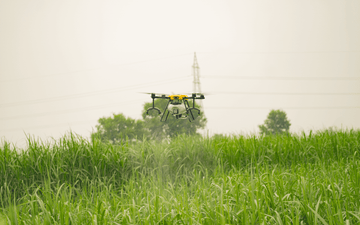Introduction
As the demand for longer flight times and more efficient aerial solutions grows, hydrogen-powered drones are emerging as a game-changing technology. Unlike traditional battery-operated drones, which are limited by short flight durations, hydrogen drones offer extended endurance, rapid refueling, and eco-friendly operation. In this blog, we explore the key advantages, challenges, and potential applications of hydrogen-powered drones.
What Are Hydrogen Drones?
Hydrogen drones use fuel cell technology to generate power for propulsion. A hydrogen fuel cell converts hydrogen gas into electricity through an electrochemical reaction, producing water vapor as the only byproduct. This clean and efficient power source enables drones to achieve significantly longer flight durations than conventional lithium-ion battery-powered UAVs.
Advantages of Hydrogen-Powered Drones
1. Extended Flight Time
Hydrogen drones can fly three to five times longer than battery-powered drones. Some models have achieved flight durations exceeding 2 hours, whereas standard lithium-ion battery drones typically last 30-40 minutes.
2. Quick Refueling
Unlike battery-powered drones that require long recharging times, hydrogen drones can be refueled in minutes—much like filling up a car with gasoline—making them highly efficient for continuous operations.
3. Eco-Friendly and Low Emissions
Hydrogen fuel cells produce zero carbon emissions, emitting only water vapor. This makes them an environmentally friendly alternative to fossil fuel-based propulsion systems.
4. Higher Payload Capacity
Since hydrogen fuel cells are lighter than lithium batteries for the same energy output, drones can carry heavier payloads, making them ideal for industrial applications such as cargo transport and surveillance.
Challenges in Hydrogen Drone Adoption
1. Hydrogen Storage and Infrastructure
Hydrogen must be stored in high-pressure tanks, which require specialized refueling infrastructure. The lack of widespread hydrogen stations limits the accessibility of this technology.
2. High Initial Cost
Hydrogen fuel cell technology is expensive to develop and integrate compared to traditional batteries, making hydrogen drones costlier upfront.
3. Safety Concerns
Hydrogen is highly flammable, and strict safety protocols must be followed during storage and transportation.
Applications of Hydrogen Drones
1. Surveillance & Security
With extended flight times, hydrogen drones are ideal for border patrol, military reconnaissance, and disaster monitoring where long-endurance surveillance is required.
2. Cargo and Logistics
Hydrogen-powered drones can transport goods over longer distances, making them useful for medical supply delivery, e-commerce, and humanitarian aid in remote areas.
3. Agriculture & Forestry
Farmers can use hydrogen drones for crop monitoring, pesticide spraying, and precision agriculture, reducing operational downtime due to frequent recharging.
4. Inspection & Maintenance
Energy and infrastructure sectors can deploy hydrogen drones for pipeline inspection, wind turbine maintenance, and power grid monitoring, improving efficiency and reducing human risk.
The Future of Hydrogen Drones
As hydrogen fuel cell technology advances, production costs are expected to decrease, making hydrogen drones more accessible and commercially viable. With increasing investments in green energy and sustainable aviation, hydrogen-powered drones are poised to revolutionize multiple industries in the coming years.
Conclusion
Hydrogen drones represent the next frontier in UAV technology, offering longer flight endurance, rapid refueling, and eco-friendly operation. Despite current challenges in infrastructure and cost, ongoing advancements in hydrogen technology are paving the way for widespread adoption. As industries continue to seek more efficient and sustainable solutions, hydrogen drones will play a crucial role in shaping the future of aerial operations.






